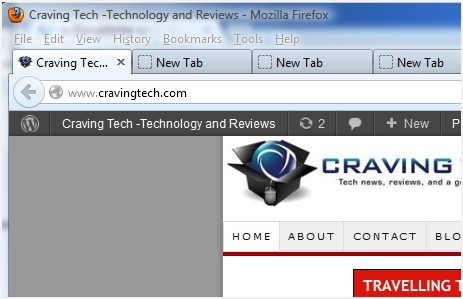Note: This is a guest post written by Bill Kilpatrick

There have been a decent number of complaints about the lack of a title bar in the Chrome browser, among other things. Support forms, tweets, and even Facebook posts still seem to be full of people asking, “Where is the title bar in Chrome?”
After finding out there isn’t one, the response is usually “Why not?” I know this because I, too, have searched for answers to those very same questions. Chrome is widely criticized (as well as praised) for this and a number of other reasons. This certainly makes sense because, after all, Chrome was intended as a bold departure from existing browsers (like Internet Explorer) and their myriad flaws (OK, especially Internet Explorer).
While a browser doesn’t need a title bar to function, it is a common element that many users expect to see. Although I totally understand the goal of eliminating clutter in the web browser, many users continue to want a title bar for, I’d imagine, a variety of reasons. Perhaps it is easier for them to move a browser full of tabs when it has a title. On the other hand, maybe they’re just so used to a title bar being there that the browsing experience feels off without it – a.k.a. the “I hate strawberries but still want to see them served with my waffles” argument.
Possible Justifications for Google Not Offering the Option
Whatever their reasons, some number of users want a title bar. So why doesn’t Google just offer the option of enabling one in the next Chrome update? Although I really don’t know for sure, I’d speculate that the thought process at Google went something like this:
“People only think they want a title bar, but it is unnecessary. If we omit the option completely, people that use Chrome will be pushed into browsing the web without one… and they’ll like it.”
I realize this characterization might make Chrome’s designers sound arrogant, but hear me out! I mean, Steve Jobs may have been one of the most arrogant people in the industry – especially when it came to stubbornly insisting on the unimaginable from designers and then introducing products that were often contrary to what users had thought they wanted. He was fine with putting people way out of their comfort zones ‘for their own good’ and, most of the time, the subsequent products turned out to be amazing.
People are fine with the frustration of change when they trust it will be worthwhile. It also helps when they’re not altogether satisfied with the status-quo: Consider how readily so many PC users make “the switch” to Mac. Now ask yourself how many people you know who, unprovoked by niche software requirements or for job-related reasons, have said, “I’ve been using Mac OS for years, but I’ve finally decided to make the shift to Windows. Yeah it’s going to be a pain, but I think it’ll be worth it, if only for the better user experience”. I’ve spoken to many people from numerous backgrounds about computers, but have never encountered anyone like this.

After getting through the initial frustrations of using a product that has been drastically re-imagined or stripped down, but in a good way, it becomes easier to identify all of the things that shouldn’t have been there in the first place. In fact, I once worried about the iPhone’s lack of a physical keyboard. Yet, having long ago made the switch, I now remember my old Blackberry phones and think, “All of those buttons… what a waste!”
So, could it really be considered pretentious to refuse adding certain options, despite sustained requests from users, because you know better? Is this kind of “arrogance” in giving users less choice such a bad thing when it comes to application/product design? If I had to characterize things in these sorts of terms, I’d say a good designer has contempt for poor design and sympathy for a user’s real needs. However, someone else might need to bridge the gap between expectations and reality – for both the end user (who might not immediately see the benefits) and the designer (who could have it all wrong).
Personally, my initial impression of Chrome was “I love the minimalism in design, speed, and simplicity of this browser… but I hate having to check the source of the web page when I need to see the full title tag”. Then I quickly realized “Oh, you can just hover over a tab and it the full title pops up”. Now I appreciate the lack of a title bar completely and without any drawbacks at all. It might have taken me longer to notice the title popup feature had I been able to enable a title bar, before never getting around to changing it. I’m sure some people know of the tooltip feature and still want a title bar, though. For them, I guess there’s always Firefox.
Note: This guest post was written by Bill Kilpatrick, a web designer who also writes about business and technology. He welcomes your feedback on Twitter @bklptrck.







Comments are closed.